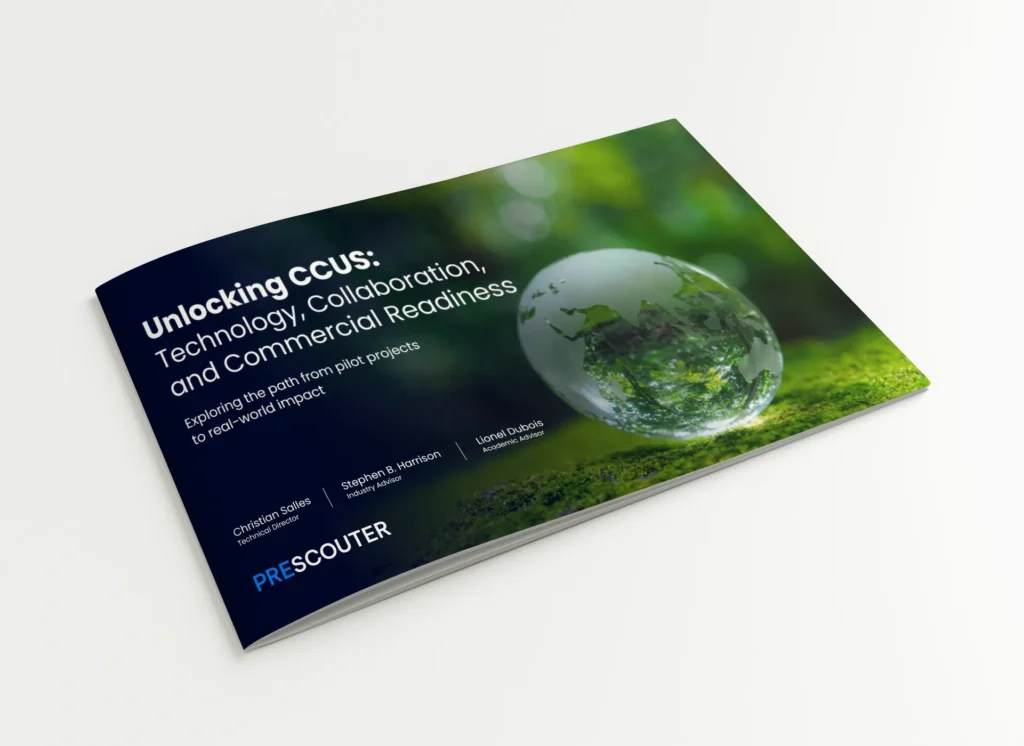Carbon capture, utilization, and storage (CCUS) is gaining attention as a necessary tool for reducing emissions in sectors where CO₂ cannot be avoided. Despite this need, CCUS projects often stall due to high energy demands, limited infrastructure, and policy gaps that fail to support a viable business case.
Here, we examine the key barriers and solutions required to advance CCUS beyond pilot stages and achieve commercial use.
What is CCUS?
CCUS involves a set of processes that captures carbon dioxide from industrial sources before it is released into the air. The captured gas is separated using methods like oxy-fuel combustion or membrane separation depending on conditions. Once separated, it is either utilized in commercial products or stored in deep underground formations.
What’s preventing CCUS from scaling effectively?
CCUS remains a promising decarbonization tool, but its deployment remains limited due to economic, regulatory, and structural barriers. These barriers are interlinked, making it harder to create momentum across industries and regions.
Here are the main factors limiting the growth of CCUS:
- The three-part dependency: Technology, infrastructure, and a workable business case must all align for CCUS to succeed. If one fails or lags behind, the entire system stalls.
- Vicious cost cycle: CCUS technologies need to be widely deployed to become more affordable, but their current high cost makes deployment difficult. This cycle discourages large-scale investments and slows down progress.
- Weak financial incentives: Carbon pricing mechanisms, such as 45Q or ETS, exist but offer limited support. These incentives often fail to cover both capital and operational expenses for CCUS projects.
- Slow infrastructure rollout: Building pipelines, ports, and terminals requires long permitting and construction timelines. Even under ideal conditions, it can take 4 to 7 years to get infrastructure ready.
- Fragmented policy and regulation: Regulatory and political frameworks vary widely between regions. This inconsistency creates planning delays and hinders cross-border collaboration.
Breaking the cost barriers in CCUS:
The commercial viability of CCUS remains fragile due to high operational costs and limited access to infrastructure. Reducing these barriers requires technical upgrades, financial frameworks, and region-specific implementation pathways.
Technological efficiency
Energy use during the regeneration phase remains the largest contributor to carbon capture operating costs. New materials, such as demixing solvents, reduce thermal demand and lower overall utility consumption. Deploying such solutions could directly improve efficiency without overhauling existing capture systems entirely.
Infrastructure investment
Pipelines remain the most scalable and cost-effective method for transporting large volumes of CO₂. To support this, shared infrastructure such as port terminals and liquid CO₂ networks is being developed across regions. By creating a common system, duplication is reduced, and more emitters can participate without large upfront costs.
Regulatory frameworks
Current carbon pricing and tax schemes do not sufficiently offset project development or running expenses. To address this, clearer regulations for cross-border pipelines and offshore storage would help attract consistent investment in infrastructure. Public institutions can reinforce confidence by issuing permits and offering financial incentives tied to project milestones.
Segmented value chain
Each part of the CCUS system demands different knowledge, from capture engineering to geological storage management. A segmented model enables firms to focus on their technical strengths while mitigating project risk. Similar structures have been successful in other industrial sectors that face cost and complexity issues.
Innovation opportunities in CO₂ Capture:
Capturing carbon dioxide remains an energy-intensive and costly process, especially when strict purity requirements are in place. As infrastructure standards grow tighter, the need for cleaner CO₂ streams pushes innovation forward. New materials, solvents, and system designs aim to reduce cost while meeting transport and storage criteria.
Purity standards
CO₂ transport now requires higher purity levels to meet the strict specifications of pipelines. This creates challenges for technologies like membranes, which struggle to maintain purity without added processing steps. As a result, developers are exploring hybrid systems that can meet purity targets while maintaining operational efficiency.
Material advancements
Membranes, MOFs, and adsorption systems continue to evolve across lab and pilot environments. These materials face trade-offs between recovery rates and CO₂ stream purity requirements. Despite progress, only a few have proven suitable for industrial-scale validation.
Next-generation solvents
New solvent types aim to cut regeneration energy while maintaining effective capture performance in industrial settings. Demixing solvents and ionic liquids support this goal, though most remain in early development stages. Hot potassium carbonate offers a practical alternative with fewer by-products compared to amine-based systems.
What collaboration models make CCUS work?
Collaboration is now central to scaling CCUS across different sectors with complex operating environments. Many emitters lack the time and resources to manage CO₂ capture, transport, and storage internally. Effective collaboration removes that complexity through specialized service models, academic support, and shared frameworks.
CCS-as-a-Service
CCS-as-a-Service allows industrial players to hand off carbon management to external technical providers. These providers operate the capture systems, coordinate logistics, and manage long-term storage facilities. By outsourcing CO₂ at a defined transfer point, emitters can stay focused on their production processes.
Specialized value chains
Scaling CCUS depends on separating technical functions across specialized players with distinct responsibilities. Asset-heavy providers may manage infrastructure while asset-light firms coordinate operations and partnerships. This approach reduces implementation risk and removes unnecessary load from companies without CCUS expertise.
Academic and public involvement
Academic experts contribute neutral insights that support policy design and increase public trust in CCUS. Their role spans from technical validation in pilot projects to helping interpret safety data for regulators. This connection between science and policy helps reduce delays caused by political hesitation.
Where to invest in CCUS today:
Investment in CCUS depends on risk tolerance, available capital, and long-term strategic direction. Some options promise higher returns but involve greater technical or commercial uncertainty. Others follow infrastructure-backed paths that offer more stable and predictable financial outcomes.
Support early-stage technologies
Venture capital firms usually fund CO₂ capture technologies like MOFs, novel solvents, and sorbents. These technologies pose a high risk because they are not yet fully scaled or commercially proven. However, investors betting early can benefit from future licensing, exits, or IP ownership.
Back infrastructure projects
Infrastructure funds often support CO₂ pipelines, shipping terminals, or large transport networks. These projects require large capital upfront, but typically offer decades of contractual stability. Their viability improves with strong policy signals and clear regulatory frameworks.








